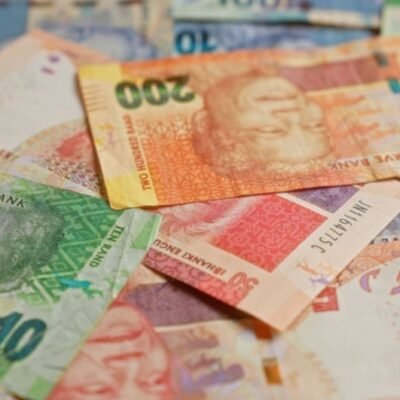WHAT IF: The family-friendly era had never begun—or never ended?
The first scenario is the less interesting and less believable of the two. Imagine that the period of themed, all-ages Strip attractions that we tend to call the “Family Vegas” era—arguably beginning in 1993 with the debut of Treasure Island’s pirate battle, the three Secrets of the Luxor Pyramid cinematic attractions and MGM’s Grand Adventures theme park, and concluding in 2008 with the closing of Star Trek: The Experience at the former Las Vegas Hilton—had never taken place. In that alternate reality, none of those attractions ever existed. Nor did the Race to Atlantis simulator ride at Caesars Palace, the Speed: The Ride launch coaster at the Sahara, the Desperado roller coaster at Primm, the still-operating Adventuredome at Circus Circus and the Big Apple Coaster (formerly the Manhattan Express) at New York-New York.
It’s nearly impossible to imagine a Vegas where none of those all-ages rides, shows and attractions existed, because that would still leave Caesars’ now-defunct Omnimax Theater and Magical Empire restaurant, not to mention the animatronic shows inside the Forum Shops; the Mirage’s volcano (sob) and white tiger and dolphin habitats; Circus Circus’ midway games and trapeze acts; the Venetian’s canal boats and short-lived Guggenheim Museum; the Wet ‘n’ Wild on the north Strip; and virtually all of Excalibur, from turret to turkey leg.
And it would preemptively eliminate current attractions like Sphere, Flyover, Arte Museum, the High Roller at Linq, Mystic Falls Park at Sam’s Town, the rides atop the Strat’s tower, Zak Bagans’ The Haunted Museum and the entirety of Area15, which recently expanded with the addition of Universal Horror Unleashed.
The lonesome death of Family Vegas can be attributed to several factors, but one above all: most of the attractions weren’t very good, even for the time. The Luxor’s rides were cringe-worthy kitsch; cultural appropriation with lap bars. MGM Grand’s theme park had few rides and very little theme. And Star Trek: The Experience … okay, that was kind of rad. But no one really seemed to believe in it: not the tourists, not the locals, not even the people who financed and designed the damn things.
“Vegas experiments a lot, and that was something they tried. The whole town didn’t buy in, and probably for good reason,” said Las Vegas Advisor publisher Anthony Curtis in an interview in 2012. “Even those who did kind of short-armed it. … They built a ‘theme park,’ but the rides weren’t good. Kids who knew good rides laughed at it.”
Even so, it’s hard to get one’s head around a Vegas that didn’t at least try that stuff. The idea of an attractions-free Vegas sort of appeals to Area15 CEO Winston Fisher, whose “immersive entertainment and events district” maintains an even balance between family and grown-up entertainment.
“There’d be a massive market opportunity to corner. You’d still have 40 million people coming [to Las Vegas] who would still like experiences. And there’d be nobody satisfying that demand; [Area15] would be the only thing.” Fisher chuckles. “I mean, it would be incredible. Oh my gosh.”
Which brings us to the second scenario: What if it had worked for the long term? What if the MGM Grand theme park had stood and flourished, and gained a variety of state-of-the-art attractions and thrill rides? What if Star Trek: The Experience had hung in long enough to be re-themed with characters from the J.J. Abrams reboot movies, or one of the new Paramount Plus Star Trek shows (which I confess I don’t watch at all)? Would Vegas have gotten more and better theme parks? Roller coasters from the airport to the hotels? A “lazy river” water attraction that encircles the entire Valley?
Or perhaps: How about an entire district of interactive attractions? The world’s second-tallest Ferris wheel? A gigantic, spherical theater that turns The Wizard of Oz into a wildly colorful, immersive burst of cinematic delirium? Perhaps the real “what if” question is: What if we simply admit to ourselves that Vegas fails only upward, even in the attraction space?
“We’re Vegas born, which is really cool,” says Area15’s Fisher. “We’re part of that ecosystem and the fabric of what makes Vegas great, which is creativity and boldness in expression. That’s what this city stands for, to me. … It is just a great entertainment city, and unabashed fantasy works really well here. Most people are scared of that, but Vegas’ history was not fearing that. Area15 was born in the right city, inspired by an incredible past.” –Geoff Carter
WHAT IF: Howard Hughes never came to Las Vegas?
On July 7, 1946, billionaire investor Howard Hughes was personally test flying his aviation company’s XF-11 prototype aircraft in California when the plane malfunctioned, causing him to crash into three Beverly Hills houses and suffer life-threatening injuries. He was not expected to survive.
Remarkably, Hughes lived for another thirty years. In that time, he’d turn out his deep pockets to purchase and fund numerous ventures, including six Las Vegas casino resorts between 1966 and 1970. While he reportedly never left his Desert Inn suite during his four-year stay, the meticulous Hughes—heir to a massive oil-drilling tool fortune, acclaimed film producer and influential aviator—ultimately wielded his obsessive-compulsive proclivities and endless bankroll en route to reshaping Sin City forever.
Today, his Strip shopping spree is widely credited as a key reason why the city was able to rid itself of its mob influences and enter a new era of widespread appeal and growth and family-friendly attractions in the later half of the 20th century.
But what if Hughes never lived to see the Desert Inn? What if his frequent recklessness—allegedly one of the reasons he nearly perished in 1946—instead led to his untimely demise?
Geoff Schumacher, veteran local journalist, historian and vice president of exhibits and programs at the Mob Museum, says that outcome would have yielded a far different future for Nevadans.
“It strikes me that if Howard Hughes had never come to Las Vegas, we would have probably had to suffer with the mob longer than we did, and I think the Strip would look different than it does today,” he says. “The monopoly pieces would be in different places, for sure, and Summerlin might not exist at all. Overall, it would have slowed Las Vegas’ growth into a metropolis, and we would not be as mature a city.”
Schumacher’s interest in Hughes’ life began when he was working on his first book, Sun, Sin & Suburbia: The History of Modern Las Vegas. He found it impossible to contain Hughes’ impact in just one chapter, leading him to pen his second book, Howard Hughes: Power, Paranoia & Palace Intrigue, in 2008. In it, Schumacher traces how Hughes invested more than $200 million to help Vegas evolve into a world-renowned destination.
“He knew he was going to buy property, mining claims, golf courses and airports, because his intention was to become a big fish in a little pond in Nevada,” he says. “He did not, at first, plan to buy casinos. It was not really in his mindset to be a casino operator.”
But Hughes’ outlook shifted a few months into his stay, when mob-connected Desert Inn proprietor Moe Dalitz tried to evict him. Instead, Hughes spent over $13 million to buy the building outright. That fateful decision kicked off a casino purchasing run that included the Sands, Castaways, Frontier, the Landmark and Silver Slipper.
Schumacher says those moves coincided with a “perfect storm of opportunity.” At the time, both Las Vegas civic leaders and the federal government agencies were “eager to shut down the mob,” while Hughes just so happened to be “willing to pay top dollar” for these mob-owned properties.
“I don’t think Hughes cared one way or the other about the mob. I don’t think that really came into his field of vision,” Schumacher says. “The context is important, though, because we’re talking about the late 1960s. There was a lot of pressure from the FBI and Justice Department, and these mob guys were aging and many of them also wanted out.”
Former Nevada Gov. Paul Laxalt rightfully saw Hughes’ investments as a boon for the state and worked to expedite things by ushering the Corporate Gaming Act through the state legislature in 1969. Schumacher says the landmark legislation opened the floodgates for corporations to buy into Las Vegas.”
“Had that not happened, I think the mob still would have been with us longer, which also might have delayed the megaresorts of the ’90s,” he says.
Hughes bought the land that would become the successful and influential master-planned community Summerlin in 1952, though it wasn’t established until almost 40 years later. And while Schumacher says Hughes “was not a great philanthropist,” his efforts to streamline casino licensing policies coincided with an agreement to contribute to Nevada’s postsecondary education system.
“That indeed became the seed money for the community colleges that we have in Nevada today, and he also gave a significant amount of seed money for the development of the medical school at the University of Nevada, Reno,” Schumacher says. “He was obviously an eccentric guy who played into the script of Las Vegas sort of being a place for outcasts and weirdos, but I don’t think that’s a bad thing. It’s kind of who we are. He helped to give us this larger-than-life identity … Now, you can ask anybody in the world about Las Vegas and they’ll know what you’re talking about. I think Hughes played a big role in all that.” –Tyler Schneider
WHAT IF: Hoover Dam had NEVER been built?
Believe it or not, water used to shoot up from the ground in Las Vegas. In fact, that’s how Las Vegas got its name—from travelers on the Old Spanish Trail who referred to it as “the meadows.”
“We had these open artesian wells that just flowed naturally,” says hydrologist and UNLV professor David Kreamer. “If you look at old pictures of Las Vegas, you can see the water just shooting up out of these pipes in the ground.”
To support the people who moved to Las Vegas in the early 20th century, water management was “pretty much totally groundwater,” he says.
But it couldn’t have stayed that way for long. As the population continued to grow into the hundreds and thousands, groundwater became scarce and would have been “completely decimated” had the government and its engineers not come up with a different way of getting water to residents.
While Las Vegas does still use a certain amount of groundwater each year, 90% of the water that supports a growing population of 2.3 million in Southern Nevada comes from Lake Mead. The human-made reservoir was created in 1936 after the construction of Hoover Dam on the Colorado River.
What if that dam had never been built?
“Without that, we’d be in a lot of trouble,” Kreamer says. “The resources probably would not have been there to sustain the population growth we’ve seen. And certainly, agriculture in California wouldn’t have been as prominent. Forty million people depend on the Colorado River, and that’s not even including the fruits and vegetables that are grown that serve other parts of the country.”
The construction of Hoover Dam was not only essential to supplying water to Las Vegas, it was also vital to the development of the Southwest, helping control irrigation for California’s powerhouse agriculture industry and producing enough hydropower to serve 1.3 million people in Nevada, Arizona and California.
Entertaining hypotheticals, we most likely would be overdrawing our groundwater, which actually led to the ground sinking in the past.
“In the 1940s, the groundwater levels in the Las Vegas Valley were going down, and we had significant problems with ground subsidence. If you pump water out of the ground, the ground surface can actually collapse, and cracks begin to appear in houses. This happened in Winchester and other places,” Kreamer says.
On a positive note, without the dam and reservoir system along the Colorado River, there would be less evaporation of river water—an issue that has been exacerbated by climate change. (Because reservoirs create more surface area for the water they contain, they’re prone to water loss through evaporation.) Kreamer estimates that Lake Mead alone loses 600,000 acre feet per year, a “significant percentage,” to evaporation.
“Without the dam, there would have been more water in the river. But it would have been uncontrolled,” he says. “I think the advantages of Hoover Dam to agriculture and population in the Las Vegas area have outweighed the negative aspects of water loss [in the reservoirs].” –Shannon Miller
WHAT IF: Nightclubs never took over the Strip?
Entertainment and nightlife have long stood as the backbone of Las Vegas tourism. It’s always evolving, always ready for a new twist inspired by current pop culture. But what if it had taken a different turn?
Instead of becoming the global epicenter for mega clubs and DJ-driven partying, what if Vegas stuck with what it did best before that evolution: lounge culture, live music and sophisticated nightlife?
If you could drop into this alternate reality, you’d find a different kind of Vegas after dark.
“I remember I would be rivaling the audience,” says Frank Marino, legendary Strip headliner known for performing as Joan Rivers for decades. “The women at the time would come in their minks, furs and designer dresses, and the gentlemen would have suits or tuxedos on.”
If those times in the ’70s and ’80s would have overpowered the casino nightclub boom that began in the ’90s, today’s scene could be without crowds dripping in fast fashion. Instead, picture a glamorous mix of 20-somethings in fitted suits and cocktail dresses, sipping martinis in intimate lounges while a bandleader, not a DJ, takes the spotlight.
“We had the Shark Club, we had Tramps, and we had the Gipsy,” Marino remembers. These independent, standalone nightclubs attracted mostly local crowds that would gather to dance ‘til sunrise without needing to set foot in a casino.
With that experience in greater demand, naturally it was time for the big casinos of the day to start building their own nightclubs, pioneering places like Ra, Club Rio, Baby’s, Studio 54 and more.
“Nightclubs were owned by independent operators in the ’90s,” says Damian Costa, a former entertainment executive at Caesars and current head of Pompey Entertainment. “But Las Vegas wanted it to become less independent. … They started competing with each other and could build to whatever scale they wanted. It was worth so much money to these properties not only because you got the spend from the customer, you got direct control as a big gaming establishment as well.”
Vegas lounge culture faded as a result. Marino doesn’t hold back on his feelings about the changes: “Every casino-hotel decided to have ultralounges and try to have nightclubs and discos. … It was just saturated. So they killed it by having too many.”
If Vegas never went so deep down that rabbit hole, casinos might have doubled down on amplifying the lounge scene with lush decor, enhanced cocktail service and performances that held your attention. Costa believes that without the surge from electronic dance music, Vegas would have seen a rise in “crooners or songsters” whose live shows would cut through.
“You get to see a bit of it on social media,” he says, “but to be able to sit with them for 75 minutes and look at the person next to you, and get validated that what you like and what you listen to, that makes you feel good.” That’s a common theme at his venue, the Composers Room in Commercial Center.
Former Weekly staffer and current Nevada Public Radio producer Mike Prevatt recalls the first stirrings of change during the rise of EDM in the 2000s.
“That EDM wave of mega clubs just got so overwhelming that people started to look for something a little more subtle,” he says. As nightclubs grew louder and more in-your-face, “there was rumbling for people that didn’t want an aggressive sound … they wanted a place that was a little mellower, a little easier to get into, but for adults and still sophisticated.”
What might Vegas have looked like if vintage lounge culture had survived and thrived? Prevatt believes it would have had to “evolve with culture,” much like it did in the ’50s and ’60s with the Rat Pack and jazz. “Vegas is always changing, whatever people are into on the Strip,” he says. “It becomes something completely different or significantly evolved.” –Gabriela Rodriguez
WHAT IF: There was no atomic testing in Nevada?
Las Vegas’ post-war popularity exploded in 1951, thanks in part to one unique attraction: atomic bombs. For more than 40 years, the Nevada Test Site operated just 65 miles northwest of Downtown, serving as one of the largest nuclear testing facilities in the country and a town-altering development for Las Vegas.
“Still today, you’re always a few degrees of separation away from somebody who worked at the test site,” says Andy Kirk, UNLV professor of history and author of Doom Towns: The People and Landscapes of Atomic Testing. “It had a big impact on Las Vegas and really was an important driver of demographic change in the 1950s and 1960s forward.”
Matthew Malinowski, director of education at the Atomic Museum, echoes that sentiment. “The test site brought skilled workers to town. It led to new university programs and brought families here for good paying jobs,” he says. “It really did have this large-scale impact on population growth within our community. The 1953 Las Vegas High School yearbook has a mushroom cloud on the cover of it, showing that pride and patriotism in the test site.”
It’s hard to imagine sunbathers watching mushroom clouds from rooftops, but it happened. And that early enthusiasm can be traced back to earlier projects that shaped Las Vegas. Kirk points to two: The creation of the Hoover Dam and Henderson’s Basic Magnesium, Inc., the largest magnesium production plant in the world during World War II.
“There was a strong tradition of embracing big federal projects that were in service of national efforts,” Kirk says. “The Nevada Test Site came on the heels of these big federal projects, and Hoover Dam and Basic Magnesium brought very favorable attention to Nevada during a time when Nevada and even Las Vegas were not really on the radar screen of most Americans.”
Atomic testing and all federal projects related were a “significant source of economic diversification,” Kirk says.
But what if that never happened in Nevada? Kirk says the government also considered Utah for a continental test site. If that had happened, Salt Lake City could’ve captured more residents and workers and the economic engine that came with testing.
Another loss: the iconic Downtown bar Atomic Liquors, where folks used to watch the tests from the roof, might not exist.
“In a way, the nuclear testing also gave Las Vegas this other element of mystique. Our city is always striving for what’s next and what’s spectacle. And when you have nuclear testing occurring in your backyard as part of your history and heritage, I see that as being a driver for what continued here,” Malinowski says. “If we weren’t the Atomic City, I think our growth could have potentially slowed. We could have had different influences on architecture and design than we have now. It could have had a whole effect on what the Strip became and what Downtown was like.”
Without the test site, “there might have been an earlier effort to think about ways to expand the economy beyond tourism,” Kirk says, adding that atomic testing was one of many trends the tourism industry capitalized on.
“And that’s really been immortalized in American pop culture—the atomic cocktails, Miss Atomic Bomb, who was recently identified,” he continues. “Celebrating Las Vegas’ connection to this most dramatic aspect of the Cold War did have a big impact on the way Las Vegas was seen nationally.”
Though Nevada prospered in many ways through this atomic legacy, it did come at a cost. Downwind communities that were exposed to radiation suffered unspeakable horrors—cancer, birth defects, premature deaths. Those affected would prefer that atomic testing never happened, and they’re certainly not alone. For them, this alternative history isn’t speculation—it’s a wish for what should have been. –Amber Sampson
WHAT IF: The Vegas Golden Knights were bad?
Las Vegans are rightfully fickle when it comes to doing stuff on the Strip. And pretty much every sports fan and journalist across the country expected the inaugural season of the NHL expansion team in Vegas to be a losing affair. So it wasn’t unreasonable back in 2017 to question whether the Golden Knights would garner strong local support.
In retrospect, it’s wholly unreasonable. We will always and forever be loyal fans. We buy and wear all the gear. We take our seats in the Fortress every year. And we shout “knight” during the National Anthem, even when we’re at a different sporting event. We are Vegas Born, even if we’re not literal natives, because we were born again with this team.
And we don’t really even need to do the whole “what if” thing, because this was always going to happen. There were three factors that connected the Golden Knights to the community in the most powerful way during that magical first season. There was the October 1, 2017 mass shooting on the Strip, and the way we responded to it together. “Vegas never really had a place to go if something happened and we all needed to join together,” says Ken Boehlke, who created the Sin Bin podcast to cover the team well before the Knights first took to the ice. “All of a sudden, nine days after the worst thing imaginable occurs, and we’ve got the meeting place. We can go be with this team that is ours, and go heal here together.”
The second and most obvious factor is that our new “Golden Misfits” just kept winning, all the way to the Stanley Cup Final. But the third factor is perhaps the most enduring and undeniable: Las Vegans were starving for something to call our own. The first major league sports team to start here—not move here—was always going to make this connection.
Even if the Golden Knights struggled to win each season, “I still think people would have been connected to it pretty heavily,” Boehlke says. “Whoever that first team would have been would have massive success because it was the first opportunity for people to have something to call their own, a logo that is ours now. If you’re in another city and you see a Raiders hat, that doesn’t mean you’re from Vegas. But if you’re wearing a VGK hat in Boston, people know where you’re from.”
The passion would have endured even if the Ls stacked up, but perhaps other sports teams wouldn’t have been so quick to join the party had the Golden Knights not achieved that ultimate success in year one. The hockey team also quickly proved the theory that fans from other cities would happily travel to see their own team play in Vegas.
“The speed at which teams rushed to get here wouldn’t have happened. I think they’d wait a little longer to see if there was longevity, if [Vegas] could actually support it,” Boehlke says. “It became obvious the Raiders were coming, but not everyone might have been as gung-ho to make that happen. It would have taken longer.” –Brock Radke
Click HERE to subscribe for free to the Weekly Fix, the digital edition of Las Vegas Weekly! Stay up to date with the latest on Las Vegas concerts, shows, restaurants, bars and more, sent directly to your inbox!










